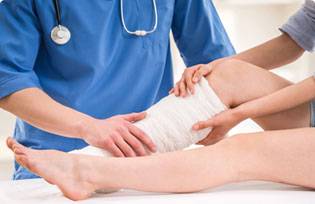Orthopedic Treatments

What is Orthopedic?
Orthopedics (also spelled orthopaedics) is a branch of medicine that focuses on the diagnosis, treatment, and prevention of musculoskeletal disorders and injuries, which affect the bones, joints, ligaments, tendons, muscles, and nerves.
Orthopedic doctors, also known as orthopedic surgeons, use a variety of methods to diagnose and treat musculoskeletal problems, including physical examinations, X-rays, MRIs, CT scans, and other imaging techniques. They may also recommend non-surgical treatments such as medications, physical therapy, and rehabilitation exercises, as well as surgical interventions when necessary.
Orthopedic conditions can range from minor injuries such as sprains and strains to more serious conditions such as fractures, arthritis, and degenerative disc disease. Common procedures performed by orthopedic surgeons include joint replacement, spinal fusion, and arthroscopy.
When should you consult Orthopedic?
You should consult an orthopedic doctor if you are experiencing any of the following symptoms or conditions:
- Pain in the bones, joints, or muscles that persists for more than a few days or is severe in nature.
- Limited range of motion or stiffness in a joint that affects your ability to perform daily activities.
- Swelling, redness, or warmth around a joint or muscle.
- An injury such as a broken bone, sprain, or dislocation.
- A deformity or abnormality in a bone or joint, such as a lump or bump.
- Chronic pain or discomfort in a joint or muscle that is affecting your quality of life.
- Symptoms of arthritis, including joint pain, stiffness, and swelling.
- Numbness, tingling, or weakness in the hands, arms, feet, or legs.
- Back pain or neck pain that is persistent or severe.
- Any other musculoskeletal issue that is causing concern.
If you are experiencing any of these symptoms, it is important to consult an orthopedic doctor for an accurate diagnosis and appropriate treatment.
What are treatments for Orthopedic?
The treatment for orthopedic conditions can vary depending on the specific condition and its severity. Here are some common treatments used in orthopedics:
- Non-surgical treatments: These can include medications, such as pain relievers, anti-inflammatory drugs, and muscle relaxants; physical therapy, which can help improve mobility and strength; and the use of braces, casts, or splints to support or immobilize the affected area.
- Surgery: When non-surgical treatments are not effective, surgery may be recommended. Orthopedic surgeries can range from minimally invasive procedures, such as arthroscopy, to more extensive surgeries, such as joint replacement or spinal fusion.
- Injections: Injections can be used to reduce pain and inflammation in a specific area. Examples include corticosteroid injections, which can be used to reduce inflammation in a joint, and hyaluronic acid injections, which can help lubricate and cushion the joint.
- Regenerative medicine: This approach involves using the body’s own healing processes to promote tissue repair and regeneration. Examples include platelet-rich plasma (PRP) therapy and stem cell therapy.
- Lifestyle changes: Making certain lifestyle changes, such as maintaining a healthy weight, engaging in regular exercise, and avoiding smoking, can also be helpful in preventing or managing orthopedic conditions.
It’s important to note that the specific treatment for an orthopedic condition will depend on the individual and the condition itself, and should be determined by a qualified orthopedic specialist.
Type of process follow by Orthopedic?
The process followed by orthopedic doctors may vary depending on the specific condition and the individual patient, but here are some common steps that may be involved in the diagnosis and treatment of orthopedic conditions:
- Medical history and physical examination: The doctor will usually begin by taking a detailed medical history and performing a physical examination, which may include checking for range of motion, strength, and any signs of injury or deformity.
- Imaging tests: Imaging tests such as X-rays, MRIs, or CT scans may be ordered to provide a more detailed look at the affected area.
- Diagnosis: Based on the results of the medical history, physical exam, and imaging tests, the doctor will make a diagnosis and recommend a treatment plan.
- Treatment: Treatment may involve a variety of approaches, including non-surgical options such as physical therapy, medications, and injections, as well as surgical interventions when necessary.
- Follow-up care: After treatment, the patient may need ongoing follow-up care, such as physical therapy, to help ensure proper healing and recovery.
- Prevention: Orthopedic doctors may also provide education and guidance on ways to prevent future injuries or complications, such as proper exercise techniques or modifications to daily activities.
Dr Rashmi Chopra
MBBS, MS, MCh,
Education MBBS, University of Mumbai, Mumbai MS, University of Mumbai,…
Dr. D. K. Das
MBBS, MS
Educational Qualification MBBS – Sambalpur University, 1996 MS – Orthopaedics…
Dr. Abhishek Kumar Mishra
MBBS,(M.A.M.C.)M.S. (Ortho),Mch (Ortho)Gold medalist
Doctor Abhishek has a vast experience in performing hip and…
Dr. Yash Gulati
MBBS, MD, DM
Detailed Experience Formerly – Hon. Surgeon to President of India…





